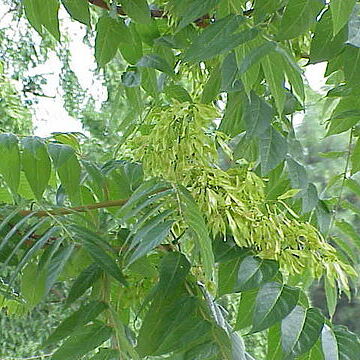Trees or shrubs, occasionally scandent, sometimes spiny, usually containing bitter substances; pubescence usually simple, sometimes glandular. Leaves spirally arranged, pinnate or simple, exstipulate or with stipular spines (Harrisonia). Inflorescences paniculate, racemose or cymose. Flowers bisexual, unisexual or polygamous. Calyx of 3–5(–6) sepals nearly always partly united, valvate to slightly imbricate. Petals 3–5(–9), rarely absent (not in Flora area), usually free, imbricate or valvate. Stamens 4–10, inserted at the base of a disc, free, sometimes with a scale attached at the base of the filament. Disc annular, pulviniform, cupular or sometimes inconspicuous (at least in dried specimens). Ovary globose or 2–5(–6+)-lobed, 2–5(–6+)-locular with 1(–2) ovules per locule, or with free carpels; styles (2–)4–8, free or variously connate. Fruit a berry or composed of drupaceous mericarps or dry mericarps attached to a central carpophore. Seed with little or no endosperm
Trees or shrubs dioecious, monoecious or bisexual. Leaves mostly alternate, pinnately compound or simple, stipulate or exstipulate. Inflorescence axillary or terminal, a raceme, panicle, thyrse or dichasial cyme. Flowers 3–8-merous, bisexual, polygamous or unisexual, regular, hypogynous. Sepals fused at base. Petals free, sometimes absent. Stamens twice as many as petals or as many as and alternate with them; filaments often with a basal appendage. Disc usually present, intra-staminal, sometimes forming a gynophore. Ovary superior; carpels free or fused; ovules usually solitary, apical and pendulous to basal and ascending. Fruit a capsule, samara, drupe or drupaceous, berry or schizocarp. Endosperm scarce or absent.
Stamens inserted at the base of the disk, equal or double the number of the petals, rarely more numerous, free, sometimes with a scale at the base; anthers 2-celled, opening lengthwise
Ovary subentire or rarely (2) 4–5-lobed, (1) 2–5-locular; loculi 1-ovulate or rarely 2-ovulate, or sometimes with 2–5 free carpels; styles (2) 4–5, free or variously united
Trees, shrubs or shrublets, occasionally ± sarmentose, sometimes spiny and with pubescence of simple, sometimes glandular hairs
Petals (3) 4–5 (9), imbricate or valvate, very rarely united in a tube (not in our area), very rarely absent (not in our area)
Ovary 2–5-lobed, 1–5-celled, or carpels quite separate; styles 2–5; ovules usually solitary, rarely 2 or more, axile
Leaves alternate or rarely opposite, imparipinnate, rarely simple, not or very rarely gland-dotted; stipules absent
Fruit a berry, or of separate drupaceous mericarps or dry angled mericarps suspended from a central carpophore
Stamens 4–10 (18), rarely ? (not in our area), free, sometimes with a scale adnate at the base of the filament
Leaves alternate (at least in our area), pinnate or sometimes simple, exstipulate
Petals 3–5, imbricate or valvate, rarely absent, free or united into a tube
Disk annular, cupular, or sometimes fused with the ovary, rarely absent
Seeds with or without endosperm; embryo straight or curved
Trees or shrubs, sometimes with bitter bark, rarely spiny
Flowers small, unisexual or polygamous, actinomorphic
Inflorescences paniculate, bracteate (in our area)
Fruit usually indehiscent, dry or drupaceous
Flowers bisexual, unisexual or polygamous
Calyx 2–5-lobed, often very deeply so
Calyx-lobes 3–5
Disk present

